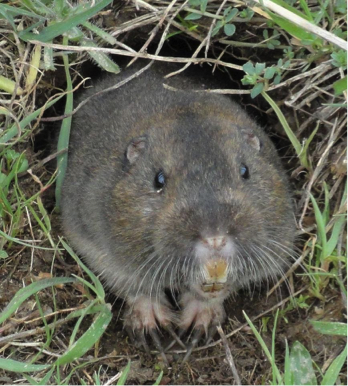Gophers
-
AboutSmall burrowing rodents that feed on roots of plants. A single gopher can inflict considerable damage in a short time. They live up to three years and eat a wide variety of vegetation, usually what they encounter while digging. Sometimes feed above ground, venturing only a body length or so from their tunnel opening.
 Photo: Ano Nuevo
Photo: Ano Nuevo -
Signs/Symptoms
Early detection is critical to prevent damage. Telltale sign are mounds of loose soil, half circles or crescent-shaped, with a plugged hole off to one side. A single gopher can create several a day. (Mole mounds are circular with a plug in the middle.) Gophers also gnaw on irrigation lines, especially the flexible tubing used for drip irrigation. In lawns, their mounds are unsightly and interfere with mowing. Gopher tunnels can divert and carry off irrigation water, which leads to soil erosion.
-
Where
Spend almost all their time underground and are not commonly seen.
-
When
Gophers don't hibernate and are active year-round. They can be active at all hours of the day and night. In irrigated areas such as lawns, flower beds, and gardens, digging conditions are usually optimal year-round, and mounds can appear at any time. In non-irrigated areas, mound building is most pronounced during winter or spring when soil is moist and easy to dig.
-
Prevent
When constructing raised beds, underlay soil with mesh wire. Protect individual plants with wire baskets when you plant them. Choose baskets large enough to allow for roots to grow for several years. Deter gophers by placing six to eight inches of coarse gravel (minimum one inch diameter) around underground flexible sprinkler lines or utility cables.
-
Manage
Use traps placed underground inside active gopher burrow. Set traps in tunnels in pairs facing each other. Cover the hole so light doesn’t get in. Check traps often and reset as necessary. Keep trapping until no new mounds are formed. Gopher traps don’t require food baits. Toxic baits pose threats to wildlife, pets, and children, especially in backyard situations.
Watch: How to set a gopher trap
Watch: How to place gopher traps
Things that don't work or are unproven:
Although many predators feed on gophers, installation of owl boxes is unlikely to reduce gopher numbers enough to prevent damage. No repellents currently sold successfully protect plants from gophers. Plants such as gopher purge, castor bean, and garlic have not been shown to repel gophers from an area. Frightening devices such as vibrating stakes, ultrasonic devices, and wind-powered pinwheels have not been effective in research trials. Fumigation with smoke or gas cartridges is not effective because gophers can seal off their burrows rapidly.
-
More Information

